|
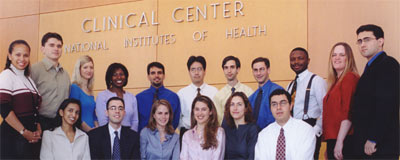
CLINICAL RESEARCH TRAINING
PROGRAM 2000-2001
| CRTP
Fellow |
School |
Clinical
Research Project |
| Hany Bedair |
Yale University |
MRI based
3D Modeling of Patellofemoral Kinematics |
| Suzette
Casal |
Duke University |
1) Comparing/contrasting
Europium to Gadolinium MRI (images in post MI animals.
2) Perfecting Gadolinium MRI images in post-MI patients.
|
| Nick Costouros |
UCSF |
Use of
Positron Emission Tomography (PET) and Magnetic Resonance
Imaging (MRI) to Assess the Effects of Anti-neoplastic Therapy
on Tumor-Associated Vasculature |
| Michael
Dimyan |
UCSF |
Central
Nervous System Motor and Cognitive Processes: Magnetic Resonance
Imaging at 1.5 to 4 Tesla |
| Jason
Gaglia |
Harvard
University |
Clinical
Trial of Islet Transplantation for Type 1 Diabetes Mellitus
|
| Shireen
Guide |
Stanford
University |
Physiogonomy
and Immunology of Pulmonary Non-Tuberculous Mycobacterium
Infections |
| Shuba
Iyengar |
Duke University |
Using
microarray technology for the classification of renal malignancy |
| Steve
Liao |
Brown
University |
MRI Evaluation
of Post Transplantation Cardiac Allograft Vasculopathy |
| Dexter
Love |
The Johns
Hopkins University School of Medicine |
Controlled
Trial of Pamidronate in Osteogenesis Imperfecta |
| Melissa
McKirdy |
Yale University |
Induction
and Characterization of Immune Response to Tumor Associated
Hy antigen in the T cell Replete and T cell Depleted Host |
| Igor Mikityansky |
Rochester
University |
Radiofrequency
Ablation |
| Karin
Minter |
Duke University |
Using
Microarray Technology to Investigate Adhesion Molecules
on White Blood Cells in Patients with Sickle Cell Anemia
(some with hydroxyurea and some with inhaled nitric oxide) |
| Jordan
Prutkin |
Yale University |
Clinical
Status and the Type III Secretion Pathway of Pseudomonas
aeruginosa in Patients with Cystic Fibrosis |
| Charles
Sansur |
University
of Maryland |
Spinal
Syringomyelia |
| Joanne
Simpson |
Wake Forest
University |
Growth
characteristics of c-kit mutation-positive mast cells in
mastocytosis |
| Stacy
Thurber |
UCLA |
Functional
Analysis of Antigen-Specific T Lymphocytes by Serial Measurement
of Gene Expression in Tumor Specimens |
| Donna
Vied |
University
of Kentucky (Dental) |
Clinical
and Basic Investigations into (Dental) Smith-Lemli-Opitz
Syndrome |

CLINICAL RESEARCH TRAINING
PROGRAM 1999-2000
| CRTP
Fellow |
School |
Clinical
Research Project |
| Stephenie
Boykin |
Yale University |
Delayed
hypersensitivity reactivity and antigen specific lymphoproliferative
responses in HIV-infected children |
| Nick Debnath |
University
of Tennessee |
Therapy
with humanized anti-CD3 antibody in a pre clinical murine
model of adult T-cell leukemia |
| Courtney
Fitzhugh |
UCSF |
A Novel
nonmyeloablative transplantation regimen: Rapamycin or Cyclosporine
to induce and maintain stable mixed chimerism in a murine
model of Sickle Cell Disease |
| Howard Fine |
Harvard
University |
Vascular
endothelial growth factor (VEGF) levels in serum and intraocular
fluid of Uveitis patients with and without Cystoid Macular
Edema (CME) |
| Chris Graber |
University
of Texas, Southwestern Medical School |
Viridans
streptococcal bacteremia in bone marrow transplant patients |
| Hiroyu Hatano |
Stanford
University |
HIV viral
load set point and side effects of highly active antiretroviral
therapy |
| Lynn Henry |
Washington
University |
Follow-up
study of patients with Onchocerciasis treated with Ivermectin |
| Joe Hoxworth |
Case Western
Reserve University |
The genetic
basis of Rheumatoid Arthritis: The NIH early synovitis cohort |
| Jennifer
Nicholson |
UMDNJ (RWJ) |
A pilot
study of orlistat (Xenical TM) in adolescents with
morbid obesity |
| Peter Rose |
The Johns
Hopkins University School of Medicine |
Musculoskeletal
manifestations and diagnostic criteria for Stickler syndrome
(hereditary arthro-ophthalmopathy) |
| Mohan Sathyamoorthy |
State University
of New York (Brooklyn) |
Genomic
scale analysis of peripheral blood lymphocytes in immune mediated
disease using cDNA microarrays. A new approach to disease
oriented clinical research. |
| Will Savage |
Cornell University |
Humoral
immune reconstitution following Non-myeloablative hematopoietic
stem cell transplant |
| Harjot Singh |
Virginia
Commonweath University |
TNF receptor
associated Periodic Syndrome: The natural history and the
investigation of the effects of Enbrel |
| Cliff Weiss |
The Johns
Hopkins University School of Medicine |
1) Simultaneous
Differentiation of Stunned, Infarcted, and Normal Myocardium
Using Magnetization Transfer Contrast Enhanced Cine MRI,
2) Evidence of Arterial Wall Inflammation in Humans by MRI,
3) MRI Detection of Arterial Wall Injury after Angioplasty |
| Stefan Weiss |
Duke University |
Measuring
health related quality of life in patients with Psoriasis |
| Samson Wu |
Duke University |
Mean transit
time measurements of acute stroke lesions by perfusion-weighted
MRI |

CLINICAL RESEARCH TRAINING
PROGRAM 1998-99 FELLOWS
| Student |
School |
Project |
| Brandon
Backlund |
University of Iowa |
Correlation of von
Hippel-Landau syndrome phentype and genotype in patients with complete
and partial deletions of VHL gene |
| Niranjan
Bhat |
Vanderbilt University |
Immunologic changes
during therapy for HIV |
| Mary
Campbell |
Columbia University |
Flavivirus vaccine
development |
| Sudhen
Desai |
Albany Medical College |
Endothelial receptors
and gene transfer |
| Edward
Garmey |
Mount Sinai School
of Medicine |
The association
of polymorphisms with the risk of infectious and inflammatory complications
among pediatric cancer populations and their implication for therapy |
| Adriana
Herrera |
University of California,
Los Angeles |
X-linked severe
combined immunodeficiency (retroviral mediated gene transfer) |
| Joseph
Hoxworth |
Case Western Reserve
University |
The study of early
synovitis using both structural and functional imaging |
| Jason
Kessler |
State University
of New York, Brooklyn |
Transaminitis in
the blood donor population |
| Joshua
Kouri |
University of Michigan |
Craniopharyngioma |
| Edward
Lahey |
Tufts University,
School of Dental Medicine |
Leukocyte adhesion
deficiency |
| Kelly
Lindhauer |
Duke University |
PET scanning and
immunoscintography |
| Stacy
Marcus |
Duke University |
Temperament and
physical performance in children with osteogenesis imperfecta |
| Michael
O'Connor |
University of Washington |
The application
of laser capture microdissection to pituitary tumors. |
| Monita
Poudyal |
University of Texas,
Southwestern Medical School |
SIV vaccine development |
| Cillford
Weiss |
The Johns Hopkins
University School of Medicine |
MRI evidence of
vascular inflammation associated with atherosclerotic disease |
| Second Year Students |
| Eric
Eskioglu |
University of Kansas |
Syringomelia |
| Uri
Lopatin |
University of Medicine
and Dentistry of New Jersey, Newark |
Acquired Lymphoproliferative
Syndrome (ALPS) |
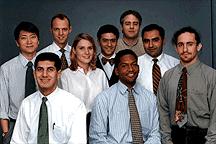
Clinical Research Training
Program 1997-98 Fellows
| Student |
School |
Project |
| Jill
Anderson |
University of Nebraska |
Construction of
retrovirus for gene therapy in interferon gamma receptor 1 and receptor
2 deficiencies |
| Amin
Azzam |
Medical College
of Virginia |
Pallister-Hall Syndrome:
Combining psychiatry and genetics |
| Eric
Brown |
University of California,
Los Angeles |
Study of adhesion
molecules in subject with acute and chronic stroke |
| Cliff
Davis |
University of California,
Los Angeles, School of Dentistry |
Oropharyngeal candidiasis
in children with HIV |
| Eric
Eskioglu |
University of Kansas |
Syringomyelia |
| Arthur
Li |
University of California,
San Francisco |
Dilated cardiomyopathy |
| Uri
Lopatin |
Unversity of Medicine
and Dentistry of New Jersey, Newark |
Acquired Lymphoproliferative
Disease (ALPS) |
| David
Robbins |
Mount Sinai School
of Medicine |
Development of immunotoxins
for lymphomas |
| Jonathan
Samuels |
Cornell University |
Psoriatic arthritis |
Clinical
Research Training Program 1998-99 Fellows
Brandon Backlund
School: University of Iowa
Project: Correlation of von Hippel-Landau syndrome
phentype and genotype in patients with complete and partial
deletions of VHL gene |

Brandon Backlund with his mentor in the
Operating Room
|
| "I think
that one of the biggest strengths of this program is
that it allows you to do a research project in any area
of medicine that interests you – surgery, medicine,
pediatrics, radiology…whatever – and provides the time
upon arrival to survey the spectrum of possibilities
and meet with a number of researchers who are doing
work in that area. |
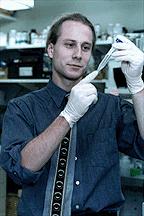
|
This
allows you to choose from among several options the
project that interests you the most, which may even
be different from what you originally thought you wanted
to do. Additionally, I have found that the program directors
are very accessibl18.jpg e, and concerned with helping
if any difficulties arise to assure that the experience
is a valuable one." |
|
|
|

Niranjan Bhat with patient
|
Niranjan Bhat
School: Vanderbilt University
Project: Immunologic changes during therapy
for HIV
"When I first started
out at the NIH, I wanted to join a student-friendly group
that worked on a disease with challenging scientific issues
and a large impact on society. I was fortunate enough to
find these qualities in the HIV clinical research group
of the Laboratory of Immunoregulation (LIR). Within the
first few months of joining the LIR, I was able to play
a significant role in writing two fascinating clinical protocols.
Both projects study the immunologic and virologic effects
of HIV therapy and deal with issues that are not only on
the forefront of HIV research, but also have wider public
interest.
|
| Frequent ward and clinic rounds have taught me about
patient care issues in the research setting, while lectures
and weekly journal clubs allow me to look at current topics
through the critical eyes of top-notch scientists. I have
no doubt that this year will have a lasting impact on my future
as a physician-scientist." |
|
|
Mary Campbell
School:
Columbia University
Project:
Flavivirus vaccine development
<Photo
currently not available>
"Spending
a year at the NIH has given me the opportunity to see how medicine
and science intersect. In my daily work, I have been able to
focus on basic science research without losing sight of the
clinical problems we are trying to solve."
|
| Sudhen Desai
School: Albany
Medical College
Project: Endothelial
receptors and gene transfer
|

|
"I went to medical school to
interact with people and engage in research. My research interests
are directly related to my clinical interests, so why even consider
a program where I had no opportunity to interact with patients?
For any clinically-oriented researcher, there is no better institution.
The NIH offers thousands of research opportunities to match anyone's
clinical interests, from patient-oriented protocols to translational
research. The most difficult decision was who to tell no."
|
|
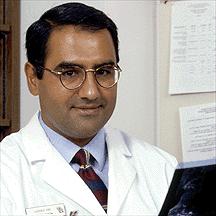
|
Eric Eskioglu
School: University
of Kansas
Project: Syringomelia
"What an incredible 18
months this has been so far! Previously being an aerospace
engineer and having done both engineering and basic sciences
research, I wanted to put my efforts into clinical translational
research in neurosurgery. Serendipitously, I came across
this brand-new program at the NIH.
|
When I started working here
I did not know the first thing about clinical research. I was
patiently nurtured and taught how to work with patients on clinical
research. The most important aspect that I’ve gained out of this
program is the skills and mindset of thinking as a clinical researcher.
In the upcoming decades, I envision myself at the cutting edge
of academic neurosurgery – one of the guys who will push the limits
of neurosurgical research. In this program I am developing into
the kind of researcher who understands the fantastic discoveries
in the basic sciences research arena and one who will have the
clinical foresight and expertise to take these discoveries and
apply them directly to clinical use.
I enthusiastically would recommend
this wonderful program to any medical student who is interested
in academic medicine, regardless of their prospective field."
|
|
Edward Garmey
School: Mount Sinai School of Medicine
Project: The association
of polymorphisms with the risk of infectious and inflammatory
complications among pediatric cancer populations and their
implication for therapy
|

Edward Garmey with Dr. Stephen Chanock
|
"The Clinical Research
Training Program rewards individualism: find your area of interest
and the sky's the limit as to what you can accomplish here. I
think of the N.I.H. as a sort of medical-scientific Disneyland."
|
|

CRTP Fellow Adrianna Herrera with Dr. Harry Malech
|
Adriana Herrera
School: University of California, Los Angeles
Project: X-linked
severe combined immunodeficiency (retroviral mediated gene
transfer)
|
"It is the ability
to ask a question at a patient's bedside and to then search for
an answer in the laboratory that makes the National Institutes
of Health so special. Furthermore,
it is the ability to allow medical students to take an active
role in this duality as physicians and scientists that makes the
Clinical Research Training Program so unique."
|
| Joseph Hoxworth
School:
Case Western Reserve University
Project:
The study of early synovitis using both structural and functional
imaging
|

Joe Hoxworth with Dr.
Hani El-Gabalawy
|
"Initially, I was reluctant
to apply to the program because it meant delaying graduation by
a year. However, the NIH Clinical Research Training Program has
exceeded my wildest expectations. We are receiving formalized
training in an area that most research-conducting physicians have
had to learn through trial-and-error."
|

Jason Kessler
School:
State University of New York, Brooklyn
Project: Transaminitis in the blood donor
population
|

Jason Kessler reviewing a chart with
Dr. Christian Koch in the clinic.
|
"Being a part of the NIH as a CRTP fellow has enabled me to witness
firsthand why this may be the premier research institution in
the world. I have heard and spoken with so many scientists, clinicians,
and investigators who have literally defined their field of interest
and who continue to expand and push the limits of our knowledge.
This alone has been an inspiring experience which can unleash
the potential of the imagination."
|
| Joshua Kouri
School:University of Michigan
Project:Craniopharyngioma
|

|
"In a typical academic center,
the research aspect is often diluted by economic pressures and
educational responsibilities. In stark contrast, CRTP students
are plunged into an environment completely devoted to biomedical
research. There are seemingly limitless numbers of scientific
lectures, research methodology courses, seminars, conferences,
and journal clubs to participate in. I believe these offerings,
in combination with the truly outstanding individual research
opportunities and mentor relationships afforded to medical students,
make this an ideal program for the aspiring physician-scientist."
|

CRTP Fellows Mike O'Connor and Joshua Kouri
|
Michael O'Connor
School: University
of Washington
Project: The application
of laser capture microdissection to pituitary tumors.
|
"The NIH Clinical Research Training Program represents an
ideal opportunity to cultivate a medical student's scientific
interests without departure from the clinical setting. For
example, the observance of a surgical procedure in the morning
is complemented by performing laboratory techniques in the
afternoon of the same day. The continuum between laboratory
bench and hospital bed is fully realized." |
|
|
Edward Lahey
School: Tufts
University, School of Dental Medicine
Project: Leukocyte adhesion deficiency
|

Ed Lahey and Dr. Brian Kelsall
|
 "While superficially the Clinical Research Training
Program can be viewed as a unique experience shared by a group
of Fellows, at its heart the program is the sharing of a group
of Fellows’ unique experiences. Its adaptability being its
greatest strength, the CRTP allows the creation of an individualized
program tailored to fit your needs and goals. As a dental
student, I have capitalized on this strength by marrying my
research interest in cellular immunology to oral medicine,
while continuing to develop my clinical dental skills. With
my laboratory research in the National Institute of Allergy
and Infectious Diseases and my clinical studies in the National
Institute of Dental and Craniofacial Research, I hope to bridge
the divide between internal and dental medicine and, in the
process, become a stronger, more research-oriented clinician." "While superficially the Clinical Research Training
Program can be viewed as a unique experience shared by a group
of Fellows, at its heart the program is the sharing of a group
of Fellows’ unique experiences. Its adaptability being its
greatest strength, the CRTP allows the creation of an individualized
program tailored to fit your needs and goals. As a dental
student, I have capitalized on this strength by marrying my
research interest in cellular immunology to oral medicine,
while continuing to develop my clinical dental skills. With
my laboratory research in the National Institute of Allergy
and Infectious Diseases and my clinical studies in the National
Institute of Dental and Craniofacial Research, I hope to bridge
the divide between internal and dental medicine and, in the
process, become a stronger, more research-oriented clinician." |
|
|

CRTP Fellow Kelly Lindauer with Dr. Ronald Neumann
|
Kelly Lindauer
School: Duke University
Project:
PET scanning and
immunoscintography
|
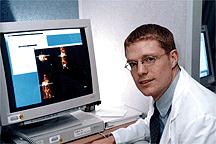
|
"The Clinical Center at NIH
sets the standards for patient-oriented research throughout the
world and the CRTP program offers a unique opportunity for medical
students to participate and gain experience in this crucial aspect
of medicine. I think the chance to learn the fundamentals behind
clinical research before graduation enhances an important area
of my medical education. By focusing on the process by which new
therapies and modes of diagnosis come to be accepted I have gained
confidence in my ability to utilize the clinical knowledge that
I have learned in medical school. In realizing now what the NIH
has to offer, I would definitely consider the NIH for subspecialty
training after residency."
|
| Uri Lopatin
School:
University of Medicine and Dentistry of New Jersey, Newark
Project:
Acquired Lymphoproliferative Syndrome (ALPS)
|
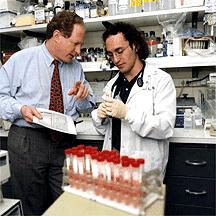
CRTP Fellow Uri Lopatin with Dr. Stephen
Straus
|
"My
two years with the Clinical Research Training Program has proved
to be one of the most academically rewarding experiences in my
life. The opportunity to work on both basic and clinical problems
simultaneously—in my case studying how cytokine dysregulation
contributes to the pathophysiology of the Autoimmune Lymphoproliferative
Syndrome—this early in my career, is both fantastic and formative.
I am learning not merely what comprises good bench research, but
also how it is integrated into cutting edge clinical work. I have
no doubt that the experiences I have gained in learning the underpinnings
of translational science will help me to be both a better scientist
and, just as importantly, a better clinician. Above and beyond
the science, the CRTP has introduced me to a community of peers
and friends (both in the CRTP and HHMI) that I hope I will carry
with me well into the future."
|
|

CRTP Fellow Stacy Marcus with patient
|
Stacy Marcus
School: Duke University
Project:
Temperament and physical performance in children
with osteogenesis imperfecta
|
"For me the CRTP has meant
moving beyond the data-gathering role in research. This program
has provided me with the time and resources to take a clinical
project from the initial question through the background research,
protocol development, data acquisition, and finally to the data
analysis stage. By being at the NIH, I am also able to use this
year to explore my interest in rehabilitation medicine more fully
than would be possible at my medical school. Lastly, the NIH provides
a never-ending stream of opportunities to learn from experts in
both clinical and basic research."
|
| Monita Poudyal
School: University
of Texas, Southwestern Medical School
Project:
SIV vaccine development
|

|
"Taking a year out of medical
school was the perfect decision for me; through the CRTP, I've
had the privilege of working alongside the country's top HIV specialists
to develop my own research protocol, recruit patients, perform
examinations and strengthen my skills in the laboratory. This
is an experience I'll carry with me into residency and career
in academic medicine."
|
|
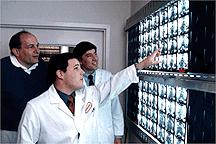
CRTP Fellow Cliff Weiss with Dr. Balaban
and Dr. Arai
|
Clifford Weiss
School: The
Johns Hopkins University School of Medicine
Project:
MRI evidence of vascular inflammation associated with atherosclerotic
disease
|
"By the time I had reached
the middle of my third year of medical school, I had already made
the decision to take a year off from the wards in order focus
solely on research. Having recently begun my clinical training,
however, I was wary of isolating myself from the clinical setting
and of losing the clinical skills and knowledge that I had been
working so hard to learn. I decided that I wanted to begin focusing
on research that was directly applicable to patient care.
While searching through the
considerable list of available projects, grants, and formalized
research programs, I found that the Clinical Research Training
Program (CRTP) was unique in its dedication to clinical research.
Not only did the program give me the opportunity to choose a clinical
research project from the entire breadth and depth of the NIH's
many institutes and laboratories, but it also provided a structured
program designed to instruct me in – and expose me to – the many
aspects of clinical research and of well-designed clinical trials.
Since
my arrival at the NIH I have not been disappointed. Between the
Core Course in Clinical Research, the CRTP journal clubs, and
the Monday night Formal Science Dinners, my education in clinical
research is well on its way. The research is exciting and the
range of projects (from genetic characterization of diseases to
full-blown clinical trials) within just the group of CRTP fellows
is astounding. The NIH is a fascinating place to do research of
every variety and I can neither imagine a better place than the
NIH – nor
a better program than the Clinical Research Training Program –
to learn about and to practice clinical research."
|
Clinical
Research Training Program 1997-98 Fellows
| Jill Anderson
School: University
of Nebraska
Project:
Construction of
retrovirus for gene therapy in interferon gamma receptor
1 and receptor 2 deficiencies.
|
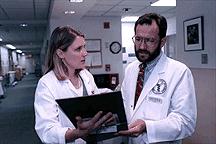
Jill Anderson and Dr. Steve Holland
|
| "Beyond the
obvious benefits of doing clinical research at one of the
top research centers in the world, the Clinical Research Training
Program (CRTP) brings together a diverse group of medical
students from across the country. From group discussions on
new scientific advances to enjoying the fun leisure activities
in Washington DC, the experience during my year at NIH will
rank among my highest." |
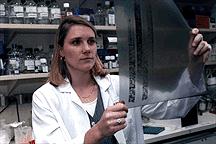
|
"Besides the
lifelong friendships made, CRTP selects outstanding clinical
scientists to serve as mentors for the program. These mentors
provide a critical role in not only the year at NIH, but for
career decisions in the future." |
|
|

CRTP Fellow Amin Azzam with Dr. Don Rosenstein
|
Amin Azzam
School: Medical
College of Virginia/Virginia Commonwealth University
Project:
Evaluating the
neuropsychiatric aspects of Pallister-Hall Syndrome
|
|

"The CRTP was an incredible opportunity to experience clinical
research firsthand. Participating in the direct application
of basic science which advances the care of human beings
was an experience that truly revolutionized my concept of
research, medical advances, and the future of medicine in
this country. The NIH is a unique academic medical center,
and I strongly encourage any medical student with an interest
in research to consider applying to the CRTP."
|
|
|
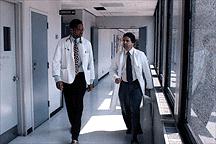
CRTP Fellow Eric Brown with Dr. Thomas
De Graba
|
Eric Brown
School:
University of California,
Los Angeles
Project:
Study of adhesion
molecules in subject with acute and chronic stroke
|
"The
Clinical Research Training Program was an invaluable experience
that taught me the detailed process of how basic research discoveries
are translated into treatments for patients. The exposure to intramural
research—and simply interacting with some of the world's best
scientists—is something that every medical student should have
the opportunity to do."
|
|
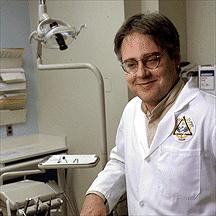
|
Cliff Davis
School:
University of California,
Los Angeles, School of Dentistry
Project:
Oropharyngeal candidiasis
in children with HIV
|
"My time spent with
CRTP was a priceless investment in my education as a caregiver.
Clinical research reinforces the critical concept that we are
caring for a whole person, not simply a disease. I also learned
the nuts and bolts of designing and conducting patient-based research.
During my year at NIH, I saw patients recieving experimental treatment
for Sjogren's Syndrome, a debilitating autoimmune disorder. I
also wrote a protocol for monitoring oral fungal infection in
young HIV patients. Other projects included pilot experiments
to treat a mouse model of Sjogren's Syndrome with gene therapy
technology. I've come back to UCLA with a fresher, more mature
perspective on my responsibilities as a professional. I'm graduating
one year later than my former classmates, but I am graduating
with a broader, more meaningful education."
|
| Arthur Li
School:
University of California,
San Francisco
Project:
Dilated cardiomyopathy
|

Arthur Li and Dr. Toren Finkel
|
"I had an incredible experience
immersing myself in the scientific cosmos of the NIH. Not only
did I become passionately involved in my main project with Dr.
Finkel, I also had the opportunity to learn from a large number
of world-class senior clinical researchers involved with the CRTP.
This program has solidified my ambitions to become an academic
physician committed to clinical research."
|
| David Robbins
School: Mt. Sinai
School of Medicine
Project:
Development of
immunotoxins for lymphomas
|

|
"The unparalleled resources
offered by the NIH combine with an intensive mentoring opportunity
from preeminent investigators in a program that is invaluable
for those medical students seriously interested in academic medicine.
I can think of no better way to freely explore the challenges
and rewards that present themselves to aspiring physician-scientists."
|
| Jonathan Samuels
School: Cornell
University
Project: Psoriatic arthritis
|
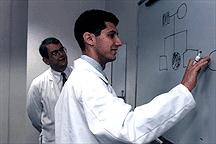
Jonathan Samuels with his mentor, Dr.
Daniel Kastner
|
"The CRTP year opened my eyes
to the wide range of opportunities available for a career in clinical
research. In working with the newly identified gene for familial
Mediterranean fever, I started, completed, and published the first
genotype-phenotype study of the disease in the U.S. In addition,
I wrote a clinical protocol for a new treatment option for this
disease."
|
Home I Clinical Research
Training Program I Letter I Fact Sheet
I Apply
I Frequently Asked
Questions
|
